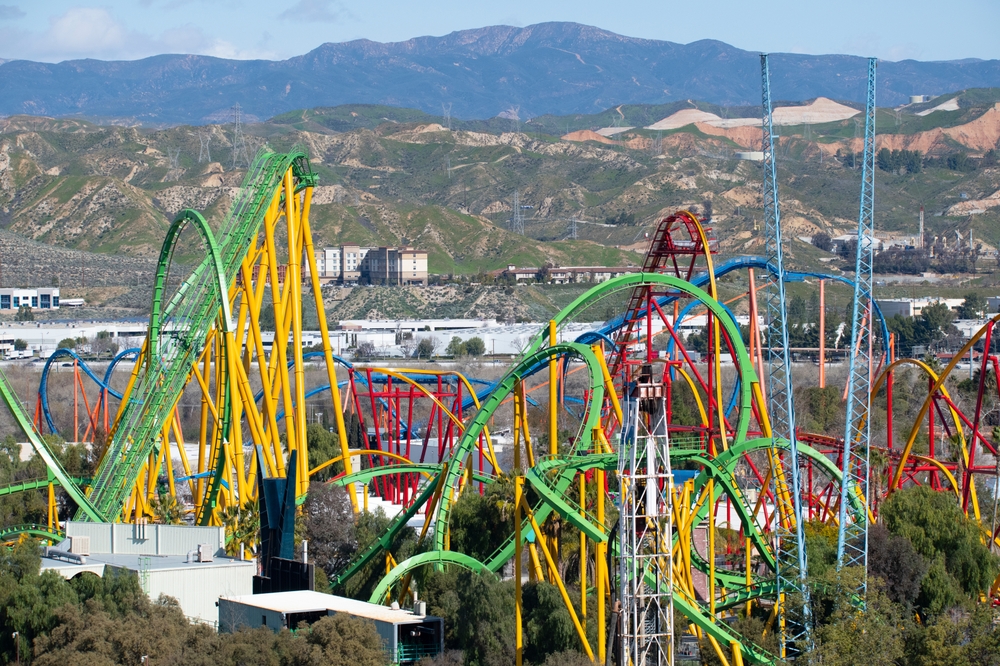How Six Flags Went Bankrupt—and Bounced Back
In the summer of 2009, Six Flags, once a dominant force in the amusement park industry, was overwhelmed by a staggering $2.7 billion in debt. Unable to refinance crucial obligations, this led to a Chapter 11 bankruptcy filing that cast a dark shadow over its future. Yet, as seen with companies like Apple and General Motors, less than a year later, emerging leaner and under new leadership, Six Flags began a dramatic comeback. This is the strategic story of how a theme park giant reinvented itself, offering vital lessons in financial restructuring, brand realignment, and aggressive strategic growth.
The $2.7 Billion Black Hole: What Nearly Drowned the Theme Park Giant
Between 1998 and 2007, Six Flags embarked on an aggressive, debt-fueled global expansion strategy. This involved acquiring numerous parks and investing heavily in new attractions and infrastructure worldwide. This rapid growth, however, created an unsustainable capital structure. By 2009, the global financial crisis brutally exposed the fragility of this model. Burdened by colossal debt and facing declining consumer spending, Six Flags found itself unable to refinance a critical $400 million obligation due in mid-June. Consequently, the company filed for Chapter 11 bankruptcy protection on June 13, 2009. Despite the financial alarm bells, management worked to reassure the public that all parks would remain open through the crucial summer season, attempting to stabilize customer confidence amidst the turmoil.
The Shocking Deal That Erased Over $1 Billion in Debt
Six Flags’ Chapter 11 filing was not an end, but a strategic maneuver for radical financial restructuring. By May 3, 2010, the company successfully emerged from bankruptcy as a consortium of hedge funds—including Stark Investments, Pentwater, and Bay Harbour—executed a pivotal debt-for-equity swap. This transformative maneuver effectively wiped out over $1 billion in liabilities, slashing total debt from a crippling $2.7 billion down to a more manageable circa $1 billion. This conversion of debt into ownership significantly reduced the company's fixed interest payments, providing immediate cash flow relief. As bondholders became the new majority owners, the company's executive leadership also saw a significant overhaul, with then-CEO Mark Shapiro replaced under the restructuring plan. This signaled a clear shift in control and strategic direction, setting the stage for recovery.

The Mastermind Who Rebooted a Beloved Brand
In August 2010, British executive Jim Reid-Anderson took charge as CEO, ushering in a new era for Six Flags. Under his pragmatic stewardship, the company's headquarters were strategically relocated to Texas, and a comprehensive brand strategy overhaul began. Reid-Anderson’s playbook focused on operational efficiency and a renewed emphasis on the core park experience. This included removing non-core intellectual properties (such as certain licensed cartoon characters that diluted the brand), streamlining park operations, and repurchasing several parks that had been previously sold off in earlier financial maneuvers. These actions re-consolidated the company's asset base and focused resources on its most profitable ventures. By 2015, Reid-Anderson’s strategy had yielded remarkable results: the company's EBITDA (Earnings Before Interest, Taxes, Depreciation, and Amortization) had surged, its market value had multiplied significantly, and, critically, guest satisfaction scores soared. This indicated a successful operational and brand-level turnaround under his focused leadership.
The Mega-Merger: Forging North America's Theme Park Empire
In a landmark move designed to achieve unprecedented scale and market dominance, Six Flags announced its merger with competitor Cedar Fair in July 2024. This strategic consolidation created the largest North American theme park operator, boasting a portfolio of 51 parks and a combined estimated valuation of $8 billion. The rationale behind this merger was clear: to significantly elevate consumer reach across key North American markets, enable vast cross-brand synergies, and realize substantial cost efficiencies through optimized purchasing power, shared technology platforms, and streamlined administrative functions. This strategic maneuver positioned the combined entity to better compete in the broader entertainment and leisure industry, setting the stage for future growth and consolidation.
Related: How Marvel Escaped Bankruptcy and Built an Empire
Billions in Debt, Billions in Revenue: Six Flags' High-Stakes New Ride
As of Q1 2025, the newly merged Six Flags-Cedar Fair entity reported $5.25 billion in long-term debt, reflecting the scale of the combined operation and the financing of the merger itself. Despite this considerable leverage, the company is generating record revenues and demonstrating strong attendance trends. Q1 2025 attendance nearly doubled quarter-over-quarter from 1.35 million to 2.82 million (reflecting a typical seasonal jump from Q4 to Q1, amplified by effective marketing and park offerings), with in-park spending per guest up by a healthy 5.5%. While the company reported a $219 million net loss in the quarter (primarily impacted by one-time integration costs associated with the merger), strong EBITDA forecasts and robust cash flow generation signal considerable long-term potential. Despite the heavy leverage, the operational momentum suggests a path towards stabilization and sustained growth through synergy realization.
Key Insights from a Rollercoaster Comeback
- What operational changes did Six Flags implement immediately after exiting bankruptcy? Immediately post-bankruptcy, Six Flags focused intensely on improving the guest experience. This involved substantial investments in park maintenance, cleanliness, and security, along with the rollout of new attractions and entertainment offerings. They also streamlined operational processes to enhance efficiency and customer satisfaction, moving away from the previous strategy of diffuse, debt-fueled expansion.
- How does the Six Flags-Cedar Fair merger aim to overcome the challenges of high debt? The merger is designed to generate significant cost synergies (estimated to be hundreds of millions of dollars) through economies of scale in purchasing, marketing, technology, and corporate overhead. These synergies, combined with increased revenue from a larger, diversified park portfolio and enhanced cross-promotion, are intended to boost profitability and cash flow, thereby improving the company's debt-servicing capacity and ultimately reducing its leverage over time.
- What are the primary competitive advantages of the new, larger Six Flags entity in the amusement park market? The combined entity's primary advantages include unparalleled geographic reach across North America, a significantly larger customer base for season pass programs, enhanced pricing power due to reduced competition, and greater bargaining leverage with suppliers and licensors. Its scale also provides a stronger platform for future technology investments, new attraction development, and marketing campaigns.
- How has Six Flags' brand perception evolved since its bankruptcy? Post-bankruptcy, Six Flags has actively worked to shed its image as a financially troubled, aging park operator. Through sustained investment in new rides, improved park conditions, and a more family-friendly marketing approach, the brand has largely re-established itself as a reliable and exciting destination for regional amusement. The merger with Cedar Fair further bolsters its perception as a leading, stable player in the industry.
Sustaining the Momentum
Six Flags’ remarkable revival demonstrates the power of decisive financial restructuring, bold leadership change, and strategic consolidation. Its recent merger with Cedar Fair significantly bolsters its scale and market position—but balancing the substantial new debt remains crucial for long-term health and flexibility to invest. With strong underlying operational indicators and clear synergy targets, the company appears strategically positioned for sustained growth. However, its financial resilience and capacity to execute merger integration flawlessly will be the ultimate determinants of its future success in the highly competitive leisure industry.














